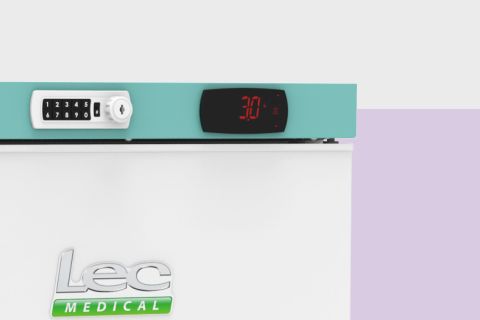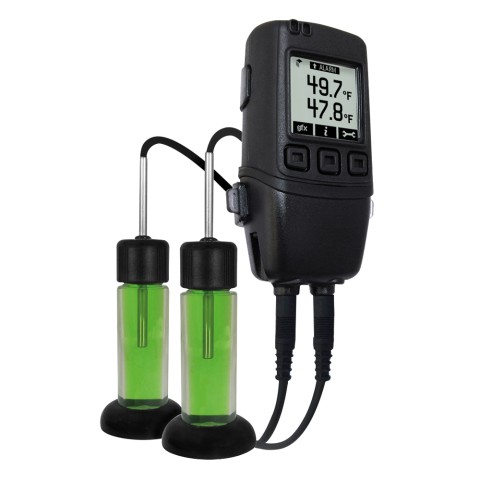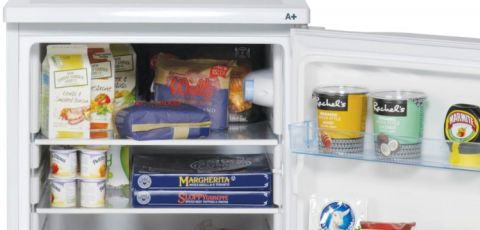
FAQ’s & Operational Guidance
This section has been divided into two parts to help you quickly find the information you need:
For general guidance and helpful tips, see the General Information section.
For appliance specific details - such as checking and resetting temperatures,
please choose the Controller Type that matches your model below.
Controller Type FAQs
Bluetooth controller
for Pharmacy Plus, Laboratory Plus and Neonatal fridge models
Essential controller
for Pharmacy Essential, Laboratory Essential, Neonatal freezer and ward models
Control Plus controller
(non-current models)
Standard digital controller
(non-current models)
General FAQs
- This is an access port which allows the probe from a secondary temperature monitoring system to be placed inside the unit, through the porthole.
- The bung is then used to seal the hole to prevent warm air getting inside the unit.
- Using the access port is preferable to placing the secondary temperature monitoring system inside the unit via the front door, as the wire from the probe would be resting against the door seal which may stop the door sealing correctly.
- The Lec Medical app is available for both Android™ and Apple® devices.
- Please follow this link
- The Lec Medical App can be used with any of the models with a Plus Bluetooth-enabled controller, including Pharmacy Plus, Laboratory Plus and Neonatal fridge models.
- Please view the quick guide to getting started with the Lec Medical App.
- The minimum and maximum temperature readings should be checked, recorded and reset twice per day, ideally at the beginning and end of the day.
- This is to ensure that the stock has not been outside of the operational temperature range for long periods of time.
- It is essential to reset the minimum and maximum temperature readings at the end of each day. During normal operations, higher temperatures may be recorded when the fridge door is opened for restocking or dispensing. If these readings are not cleared, they will remain visible the following morning and may cause unnecessary concern about potential issues, such as an overnight power failure, when no problem has occurred.
- Models with two temperature sensors can monitor both the air temperature inside the appliance and the simulated temperature of the vaccines or milk, using a temperature sensor probe which is immersed in a vial of liquid.
- The air temperature can rise rapidly when the appliance door is opened to remove items or to restock the unit but will start to stabilise again when the door is closed.
- The load temperature, on the other hand, remains much more stable as it would take much longer for the core temperature of the vaccines or milk to rise when the door was opened.
- For this reason, the load temperature tends to give the most accurate results.
- (Laboratory models measure the air temperature only).
- When using the Lec Medical App, you can easily view, check and reset both the air temperature and the load temperature.
- The temperatures recorded by the controller can vary slightly from those recorded by a separate data logger or secondary temperature monitoring system, for a number of reasons.
- If the controller is recording load temperatures while the data logger is recording air temperatures, the load temperature will normally be lower and more stable than the air temperature as it is not as affected by door openings.
- Pharmacy, Ward and Neonatal units have internal fans which circulate the cool air to give a more even temperature throughout the storage compartment. Laboratory units do not have internal fans and so the internal temperature will be coldest and the bottom and a little warmer at the top. The data logger should be positioned at the bottom of the unit to record the most accurate temperatures – if the data logger was positioned at the top then it would record slightly higher temperatures.
- Yes, even though the temperature sensor probes inside the appliance are extremely accurate, it is always best to use a separate temperature data logger or secondary temperature monitor as well.
- This is so that temperatures will always be monitored and recorded even if the refrigeration appliance experiences a power outage, because they have their own independent battery power source, and is particularly important when using refrigeration appliances without an internal battery back-up system.
- At least once per year.
- Yes, some models have remote alarm contact terminals which allow remote alarms to be connected.
- These allow an external alarm to be connected and to sound at a monitoring point away from the fridge if the fridge reports a door open, high temperature or low temperature alarm, or if the fridge experiences a power failure, alerting colleagues to attend to the fridge and to move the stock to another unit of the same type which is working normally.
- Please check the specifications tables on the product pages when looking for a model with this feature, and please check the user manual for details on connecting the external remote alarm.
- Fridges will defrost themselves automatically.
- Freezers should be defrosted at least twice a year, or when the frost build-up is more than 5mm thick.
- Do not use metal instruments or external heat sources like hairdryers to remove the ice or speed up the defrosting process as irreversible damage to the appliance may result.
- When the motor is running and the fridge is cooling down it is normal for a small amount of frost to build up on the internal back wall. The frost will melt and the meltwater will drain away when the motor is off and the fridge is going through its automatic defrost cycle.
- More ice may build up in very humid locations. If necessary, please refer to the user manual for details of how to initiate a manual defrost on the controller.
- During the defrost cycle the frost melts and the meltwater drains into a drain hole in the centre of the back wall, just above the basket.
- If the drain hole is blocked, the meltwater will not be able to drain away, and the water will collect on the base of the fridge.
- Please clear the drain hole with a blunt non-metallic object, such as a straw or cotton bud, or by pouring two tablespoons of warm water down the hole.
- Condensation forms when warmer moister air meets a cold surface, and so tends to form when room temperature air meets the colder surface of the door when the door is open.
- This is not a cause for concern, and the condensation will usually clear shortly after the door is closed again.
- Condensation tends to be more noticeable in warmer rooms and/or in areas of high humidity.
- This is nothing to worry about.
- Refrigeration appliances work by ‘extracting’ heat from the inside of the cabinet and transfer this heat to the room via the condenser. The Lec Pharmacy and Laboratory models have the condenser units in the side walls and so give out heat from these locations.
- The heat will be more noticeable when the motor is running and the appliance is cooling down, and tends to be more noticeable on smaller counter-top units with smaller sides as there is less surface area for the heat to radiate from.
- Yes, please contact UK spares on 01454 620 500
- If a lock has failed under the manufacturer’s warranty, please contact the customer support team at https://www.lec-medical.co.uk/en-gb/contact
- Please move the stock to another working refrigeration unit of the same type; then power off and unplug the unit to be cleaned.
- Clean the inside and outside of the appliance with a wrung-out soft cloth which has been immersed in lukewarm water containing a mild detergent.
- Rinse with a wrung-out soft cloth which has been immersed in clean lukewarm water, then dry thoroughly.
- For Neonatal models, it is recommended to use a food-safe sterilization fluid for cleaning, such as Milton® Sterilising Fluid.
- For Neonatal models, it is recommended to remove the drawers/shelves and basket before cleaning the side walls, drawers/shelves and basket.
- For Neonatal models, if the unit still contains expressed milk during cleaning, do not leave the door open for more than 1 minute in every 10-minute period. Using the Lec Medical App or controller, check the displayed load (L) temperature during and after cleaning to ensure that the core load temperature has not risen above 4°C.
- It is sensible to always have at least two refrigeration units of the same type available in a location.
- This way, if there is ever an issue with one unit, the stock can be moved to another working unit of the same type.
- If the appliance is new or has been moved, it must be left to stand for 24 hours before being switched on. If 24 hours has not yet elapsed, switch the unit off immediately and let it stand for 24 hours before switching on again.
- Ensure that the appliance is plugged into the socket correctly and switched on. Try replacing the 13-amp fuse in the plug. If possible, try plugging a different electrical appliance into the socket to check that the socket is working.
- Please check that the power supply cable is not damaged. If it is damaged, please contact the customer support team on 0344 815 3742
- Please check that the room the unit is located in is not too hot or too cold – refrigeration units generally cannot operate properly in rooms which are cooler than 16°C or warmer than 32°C.
- Please note that the fridge motor will not run constantly; when the appliance is cold enough the motor will rest, and the motor will not run when the fridge is going through a defrost cycle. Therefore, the absence of motor sound does not necessarily indicate a fault as long as the fridge temperature is staying within its normal operation range.
- Please check that the door is closing and sealing well. Reposition any items which are preventing the door from closing well.
- For models with a rear access port for introducing external temperature sensors, please ensure that the access port is correctly sealed with the bung.
- Please check that the room the unit is located in is not too hot or too cold – refrigeration units generally cannot operate properly in rooms which are cooler than 16°C or warmer than 32°C (cooler than 25°C or warmer than 32°C for neonatal models).
- Please see initial set-up page to ensure positioning of the appliance is correct.
- For pharmacy, ward and neonatal models, please check that the internal fan is running as usual. As you open the door you should be able to hear the fan coming to a stop; if the fan was already stopped when you opened the door, this could indicate an issue.
- Please check that the set point is not set too high or too low – please check the user manual for details.
- If the issue persists, please move the stock immediately to another refrigeration unit of the same type which is working normally, and contact the customer support team on 0344 815 3742
- The controller will show the lowest recorded temperature and the highest recorded temperature since it was last reset.
- If the appliance door has been opened for a longer period, for example for restocking, since the last reset, a higher temperature will have been recorded at that point.
- However, if there is no alarm recorded, this means that the temperature then restabilised once the door was closed and got back to within the normal operating range within 10/15 minutes, and so there is no issue because it is unlikely that the core load temperature of the items would have gone outside of the normal operating range within 10/15 minutes.
- Please check that the appliance is level, is not knocking against adjacent furniture, and that items inside the unit are not rattling or jostling against each other.
- With refrigeration appliances, some sounds will be produced during normal operation and are unavoidable. These include a clicking sound when the motor starts, the sounds of the motor and internal fan running, and the ‘whooshing’ and ‘gurgling’ sounds caused by the movement of refrigerant gas around the pipework.
- Should there ever be the sound of running water and the appliance is not cooling down, please move the stock immediately to another refrigeration unit of the same type which is working normally, and contact the customer support team on 0344 815 3742




